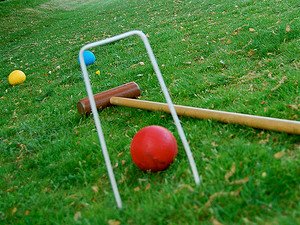Croquet Rules

Whilst croquet is played internationally it is, perhaps the most quintessentially English game imaginable. A game of croquet, a glass of Pimm’s and a cucumber sandwich on a rare sunny day in England – what could be finer? Many things, perhaps, but let’s look at the rules anyway!
Croquet’s first rules were registered in 1856, although there are suggestions similar games were played as early as the 1600s. There are many different variants of the game and slightly altered versions popular in other parts of the world. In the simplest form, however, they all involve hitting balls across a prepared lawn through hoops using a wooden mallet. We will consider the Official Rules of Garden Croquet, here, as per the World Croquet Federation.
Object of the Game
The object of the game is to manoeuvre your balls over the lawn and through the six hoops in the right direction and correct order and then “peg out” by hitting the central peg.
Players & Equipment
The game can be played one against one (singles) or two against two (doubles) and the rules are the same in either version of croquet. One side uses a black ball and a blue one, with the other teams using red and yellow and these are 3? inches in diameter and weigh one pound.
In addition to the balls each player also needs a wooden mallet to strike them with. There are few regulations regarding the mallet and they are usually 2.5-3.5 pounds in weight, 24-40 inches long, with a head around nine to 12 inches long and a square face, although round faces are also used.
The lawn is normally 17.5m by 14m but for the casual player any decent sized, relatively smooth grass area will suffice. At croquet clubs where the grass is shorter and therefore faster a standard lawn may be as big as 32m x 25.6m. The important thing is that the proportions are kept roughly the same.
The hoops are made from metal for competition play and are 12 inches high and 3¾ inches wide, only slightly wider than the balls. The hoops are laid out in a set configuration, with, roughly speaking, numbers one and two on the left side at either end, three and four on the right side and five and six in the middle and slightly nearer the peg in the middle that is used for the start and end of the game.
Scoring
In association croquet, of which garden croquet is a derivative, you score a point for getting each ball through each hoop and then an additional point for hitting the peg with each ball, giving a maximum of 14 points.
Winning the Game
A side or player wins by scoring 14 points first, that is to say passing both balls through all six hoops and then pegging each ball out.
Rules of Croquet
- A coin toss determines who goes first with the loser of the toss picking which balls to use.
- Each player plays in turn, taking one shot unless extra shots are earned. Extra shots are gained by either “running a hoop” (passing through the correct hoop) or hitting one of the other three balls. These earn one and two extra shots respectively.
- The first four turns must be used to bring all four balls into play, after which you can choose to play either ball, although extra shots can be earned immediately.
- If you hit another ball (make a roquet) and earn two extra shots the first of those (the croquet shot) must be played in contact with the roquet ball. In order to do that you move your ball and place it anywhere in contact with the ball that was hit. The roqueted ball must move or shake with the next strike. The next shot is called the continuation shot and must be played from where the first, original ball lies.
- Extra shots are not cumulative and you can only earn extra shots once from each ball until the next hoop is scored.
- If a ball is struck off the lawn or lies within a metre of the edge it is moved to a metre inside the lawn. There is no penalty for this.
- To score a hoop no part of the ball must be visible on the original side of the hoop – that is to say, all of the ball must have passed at least some part of the hoop.
- The ball can only be struck with the face of the mallet and must be hit cleanly without moving the other balls, hoops or peg to make the shot.
- Once a ball hits the peg at the end of the game it is removed from play.